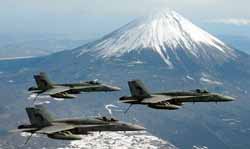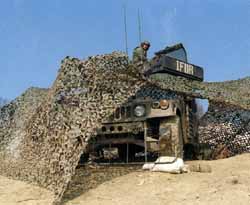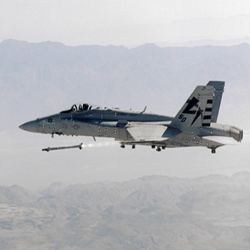Daily News
by Gail Helmer
[ Send Us News | Archives ]
F/A-18 Program Surpasses 5,000,000 Flight Hours
As F/A-18 Hornet pilots took to the skies Dec. 12, they marked a notable moment in the aircraft's history, helping the program go over 5 million total flight hours. U.S. and international F/A-18 pilots commemorated the event around the globe.
"The most interesting aspect of the 5 million F/A-18 flight hours is that each consecutive million has been more capable, survivable and successful," said Capt. Jeff Wieringa, F/A-18 program manager for the Naval Air Systems Command (NAVAIR). "The earliest model F/A-18A aircraft, some of which have been flying now for 20 years, has been enhanced to keep it ahead of the evolving threat. The newest model of the F/A-18, the Super Hornet, is one of the nation's finest examples of evolutionary acquisition and spiral development."

There are currently 1,290 Hornets flying in 58 active-duty, reserve and test squadrons, as well as in seven foreign countries. The F/A-18s have been involved in every major U.S. military conflict since the early 1980s.
Joining the Hornets in Operation Southern Watch is the new F/A-18E Super Hornet model, currently flown by Strike Fighter Squadron 115 of Carrier Air Wing 14 (CVW-14). CVW-14 flies from the flight deck of USS Abraham Lincoln (CVN 72).
One of the first squadrons airborne on the day of the milestone was Strike Fighter Squadron 192 from USS Kitty Hawk (CV 63), which is permanently forward-deployed and operating out of Yokosuka, Japan.
"We are proud to be part of this impressive milestone in Hornet history," Kitty Hawk Commanding Officer Cmdr. James Paulsen said. "It is a tribute to our maintenance program and the Sailors who are maintainers that we have been able to continue to make the Hornet such an irreplaceable part of Naval aviation."
U.S. Marines from Marine Fighter Attack Squadrons 122 from Marine Corps Air Station Iwakuni, Japan, and pilots from the Royal Malaysian Air Force were also part of the first time zone to announce their participation.
Five million flight hours constitutes quite an achievement, but, more importantly, it provides the background for further development of the F/A-18E/F Super Hornet.
Super Hornets possess the capacity in space, electrical power and cooling to accommodate the new weapons, sensors and countermeasures under development today. It will continue to evolve in a carefully planned progression well into the 21st century.
NAVAIR provides advanced warfare technology through the efforts of a seamless, integrated, worldwide network of aviation technology experts.
Lithuania To Buy Stinger Weapon Systems
The U.S. Army has approved the sale of Raytheon-made Stinger surface-to-air missiles to Lithuania. The $21 million agreement was signed during a ceremony in Vilnius, according to a news release. Lithuania will buy vehicle-mounted Stinger launch platforms, missiles, two ThalesRaytheonSystems radars and training and support equipment.

The systems will be mounted on Humvees, according to Duane Gooden, Raytheon's Stinger program director. Paul Walker, Raytheon vice president, says the missiles are part of a building block to qualify the country for admission into NATO, the North Atlantic Treaty Organization.
Raytheon Awarded AIM-9X Contract
Raytheon Company has received a $96.2 million contract for continued production of the AIM-9X Sidewinder short-range air-to-air missile. The award was made by the U.S. Naval Air Systems Command, Patuxent River, Md.
AIM-9X is currently undergoing Operational Evaluation (OPEVAL) by both the U.S. Navy and Air Force to determine its overall readiness for each service. The OPEVAL segment of testing consists of 22 guided launches, numerous hours of captive flight evaluation, and extensive testing of the associated logistic equipment.

The AIM-9X is a joint U.S. Navy and U.S. Air Force program currently in engineering and manufacturing development. It is the newest member of the AIM-9 Sidewinder short range missile family in use by more than 40 nations.
Raytheon to Provide RAM for Korean Navy Ships
Raytheon Company has been awarded a $32.3 million contract by the Republic of Korea (ROK) Navy to provide Rolling Airframe Missile (RAM) guided missile weapon systems for the next three KDX-2 (Batch 2) multipurpose destroyers and the first of class LPX Amphibious Assault Ship.
This is the second sale of the RAM weapon system in Korea. Raytheon's RAM weapon system continues to provide the ROK Navy with vital defense against anti-ship missiles and will strengthen the ROK Navy multi-layer.

The first RAM System has been successfully installed onboard KDX-II Ship 1 and is awaiting at-sea integration testing scheduled for next year. The ROK is the third nation to purchase and deploy the RAM Weapon System, which was cooperatively developed and produced by the United States and Germany.
RAM's passive dual mode (infrared and radio frequency), autonomous missile provides high firepower since no shipboard support is required after launch. The RIM 116A missile selected by Korea has completed its U.S. Navy operational test program and continues full rate production in order to satisfy U.S. Navy and foreign navy self-defense requirements. RAM continues to be selected as the weapon of choice by the Republic of Korea Navy for anti-ship missile defense.
[ Send Us News | Archives ]
by Gail Helmer
Wednesday December 18, 2002
- F/A-18 Program Surpasses 5,000,000 Flight Hours
- Lithuania To Buy Stinger Weapon Systems
- Raytheon Awarded AIM-9X Contract
- Raytheon to Provide RAM for Korean Navy Ships
F/A-18 Program Surpasses 5,000,000 Flight Hours
As F/A-18 Hornet pilots took to the skies Dec. 12, they marked a notable moment in the aircraft's history, helping the program go over 5 million total flight hours. U.S. and international F/A-18 pilots commemorated the event around the globe.
"The most interesting aspect of the 5 million F/A-18 flight hours is that each consecutive million has been more capable, survivable and successful," said Capt. Jeff Wieringa, F/A-18 program manager for the Naval Air Systems Command (NAVAIR). "The earliest model F/A-18A aircraft, some of which have been flying now for 20 years, has been enhanced to keep it ahead of the evolving threat. The newest model of the F/A-18, the Super Hornet, is one of the nation's finest examples of evolutionary acquisition and spiral development."

There are currently 1,290 Hornets flying in 58 active-duty, reserve and test squadrons, as well as in seven foreign countries. The F/A-18s have been involved in every major U.S. military conflict since the early 1980s.
Joining the Hornets in Operation Southern Watch is the new F/A-18E Super Hornet model, currently flown by Strike Fighter Squadron 115 of Carrier Air Wing 14 (CVW-14). CVW-14 flies from the flight deck of USS Abraham Lincoln (CVN 72).
One of the first squadrons airborne on the day of the milestone was Strike Fighter Squadron 192 from USS Kitty Hawk (CV 63), which is permanently forward-deployed and operating out of Yokosuka, Japan.
"We are proud to be part of this impressive milestone in Hornet history," Kitty Hawk Commanding Officer Cmdr. James Paulsen said. "It is a tribute to our maintenance program and the Sailors who are maintainers that we have been able to continue to make the Hornet such an irreplaceable part of Naval aviation."
U.S. Marines from Marine Fighter Attack Squadrons 122 from Marine Corps Air Station Iwakuni, Japan, and pilots from the Royal Malaysian Air Force were also part of the first time zone to announce their participation.
Five million flight hours constitutes quite an achievement, but, more importantly, it provides the background for further development of the F/A-18E/F Super Hornet.
Super Hornets possess the capacity in space, electrical power and cooling to accommodate the new weapons, sensors and countermeasures under development today. It will continue to evolve in a carefully planned progression well into the 21st century.
NAVAIR provides advanced warfare technology through the efforts of a seamless, integrated, worldwide network of aviation technology experts.
Lithuania To Buy Stinger Weapon Systems
The U.S. Army has approved the sale of Raytheon-made Stinger surface-to-air missiles to Lithuania. The $21 million agreement was signed during a ceremony in Vilnius, according to a news release. Lithuania will buy vehicle-mounted Stinger launch platforms, missiles, two ThalesRaytheonSystems radars and training and support equipment.

The systems will be mounted on Humvees, according to Duane Gooden, Raytheon's Stinger program director. Paul Walker, Raytheon vice president, says the missiles are part of a building block to qualify the country for admission into NATO, the North Atlantic Treaty Organization.
Raytheon Awarded AIM-9X Contract
Raytheon Company has received a $96.2 million contract for continued production of the AIM-9X Sidewinder short-range air-to-air missile. The award was made by the U.S. Naval Air Systems Command, Patuxent River, Md.
AIM-9X is currently undergoing Operational Evaluation (OPEVAL) by both the U.S. Navy and Air Force to determine its overall readiness for each service. The OPEVAL segment of testing consists of 22 guided launches, numerous hours of captive flight evaluation, and extensive testing of the associated logistic equipment.

The AIM-9X is a joint U.S. Navy and U.S. Air Force program currently in engineering and manufacturing development. It is the newest member of the AIM-9 Sidewinder short range missile family in use by more than 40 nations.
Raytheon to Provide RAM for Korean Navy Ships
Raytheon Company has been awarded a $32.3 million contract by the Republic of Korea (ROK) Navy to provide Rolling Airframe Missile (RAM) guided missile weapon systems for the next three KDX-2 (Batch 2) multipurpose destroyers and the first of class LPX Amphibious Assault Ship.
This is the second sale of the RAM weapon system in Korea. Raytheon's RAM weapon system continues to provide the ROK Navy with vital defense against anti-ship missiles and will strengthen the ROK Navy multi-layer.

The first RAM System has been successfully installed onboard KDX-II Ship 1 and is awaiting at-sea integration testing scheduled for next year. The ROK is the third nation to purchase and deploy the RAM Weapon System, which was cooperatively developed and produced by the United States and Germany.
RAM's passive dual mode (infrared and radio frequency), autonomous missile provides high firepower since no shipboard support is required after launch. The RIM 116A missile selected by Korea has completed its U.S. Navy operational test program and continues full rate production in order to satisfy U.S. Navy and foreign navy self-defense requirements. RAM continues to be selected as the weapon of choice by the Republic of Korea Navy for anti-ship missile defense.
